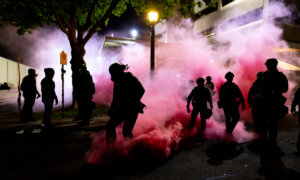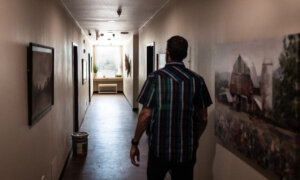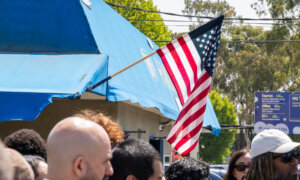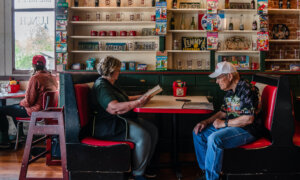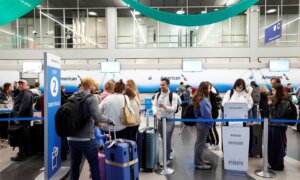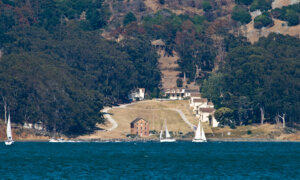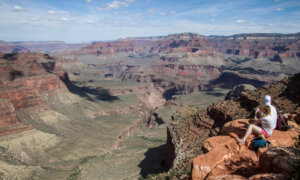LOS ANGELES—In a narrow corridor between Los Angeles International Airport (LAX) and the beaches of Playa Del Rey, Calif., a framework of cracked asphalt streets is lined with unkempt palm trees behind chain-link fencing, as outgoing passenger jets pierce the sky with the rumble of jet engines.
“I walk through this place all the time, but I’m unaware of its history,” a man walking just outside the fence line told The Epoch Times. “Nor have I ever really thought about it, to be honest.”
Several feet away behind the fence once stood hundreds of homes that made up “Surfridge,” a coastal neighborhood in southern Playa Del Rey, nestled between the streets of Pershing and Vista Del Mar.
At its formation in 1921, real estate developers Dickinson & Gillespie sold land lots within the former beachside neighborhood for $50 down and $20 per month for a three-year period, according to the Los Angeles Times.
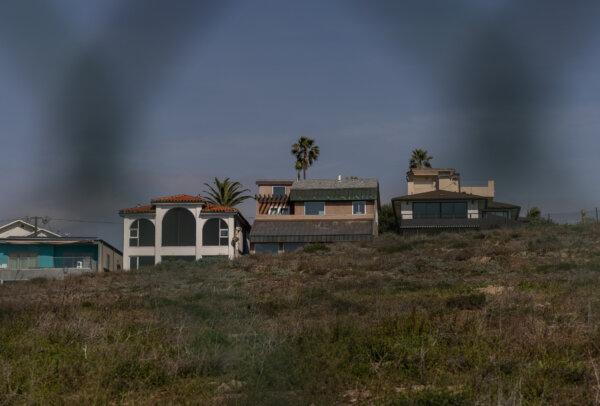
A fence lines the former location of the "Surfridge" neighborhood in Playa Del Rey on Feb. 14, 2024. (John Fredricks/The Epoch Times)
Part of a three-mile stretch of coastal property owned by the developers, the land was advertised as “the last of the ocean front contiguous to Los Angeles” in an effort to attract residents seeking to build a home. But it was not until the mid-1930s that many customers began to take advantage of the housing opportunity because of the financial repercussions of the Great Depression, according to the Los Angeles Times.
With the neighborhood’s elevation at 135 feet above sea level, residents had beautiful ocean views stretching for miles down the coast in both directions.
Immediately to the neighborhood’s east was a small dirt airfield that welcomed propeller planes and began operations in 1928. The airstrip itself was the precursor to the modern-day LAX.
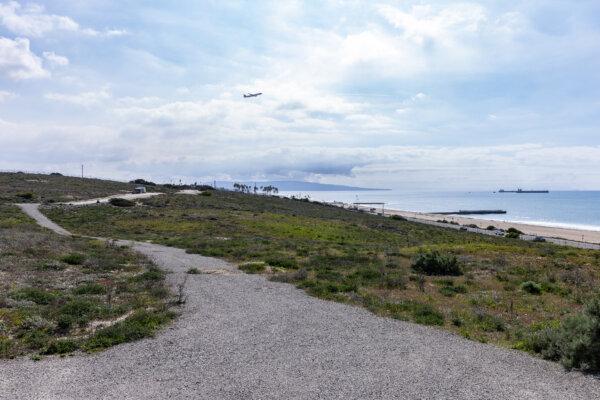
The former streets of the Surfridge neighborhood in Playa Del Rey on Feb. 14, 2024. (John Fredricks/The Epoch Times)
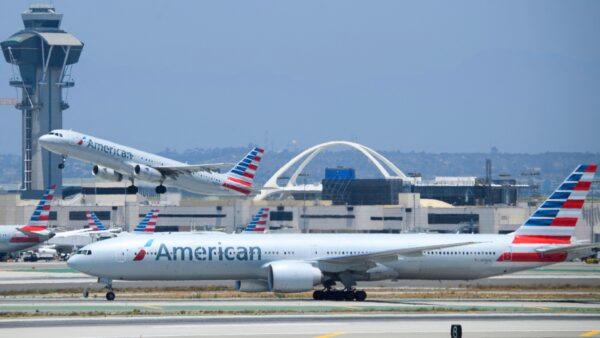
An American Airlines Airbus A321 aircraft takes off as a Boeing 777-300 taxis on the tarmac at Los Angeles International Airport in Los Angeles on July 6, 2021. (Patrick Fallon/AFP via Getty Images)
LAX Expansion
For local residents, the sound of airplanes has simply been part of the experience of moving into the area.
“When I moved here in 1986, it was pretty obvious we were going to hear airplanes left and right,” Jean Rezzo, whose Playa Del Rey home overlooks the former Surfridge area, told The Epoch Times.
“I bought a home here shortly after Surfridge was already gone, but I can still remember having access to the sand dunes near it while attending college nearby in the ‘70s and seeing the planes constantly fly over where the neighborhood used to be.”
As the airport grew, the quieter propeller-powered passenger aircraft of the 1940s tuned into the louder, jet-engine aircraft of the 1960s, which also came with an increase in air traffic over Surfridge—at that time located at the end of LAX’s runways because of the airport’s expansion.
The Federal Aviation Administration soon required residential rezoning of the area to align with airport operations. Los Angeles World Airports, the LAX airport authority, eventually bought the land from Surfridge residents under eminent domain, according to airport officials.
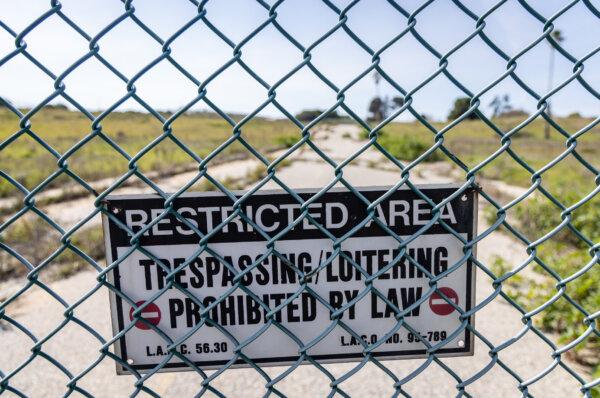
The former streets of the Surfridge neighborhood in Playa Del Rey on Feb. 14, 2024. (John Fredricks/The Epoch Times)
“Los Angeles World Airports (LAWA) acquired the land and properties of the present-day LAX Dunes following the start of the ‘jet age,’ which was when jet-powered aircraft were introduced in the 1960s,” Dae Levine, a Los Angeles World Airports spokesperson, told The Epoch Times. “As the number of jets and volume of air traffic increased, so did aircraft noise.”
With the airport’s acquisition of Surfridge’s 800 homes, most residents had relocated elsewhere by the early 1970s, while others moved their houses across town to northern Playa del Rey, according to former residents.
“One of the homes that I know of that was moved during that time cost $5,000 to move and re-attach it to a new location,” longtime Playa Del Rey-now El Segundo resident Michael Lind told The Epoch Times. “I lost a lot of friends that had to move out of [Surfridge] with their families at that time.”
For him, growing up in Playa Del Rey near the empty neighborhood meant driving “fast cars” around the abandoned area before it was sealed off from the public.
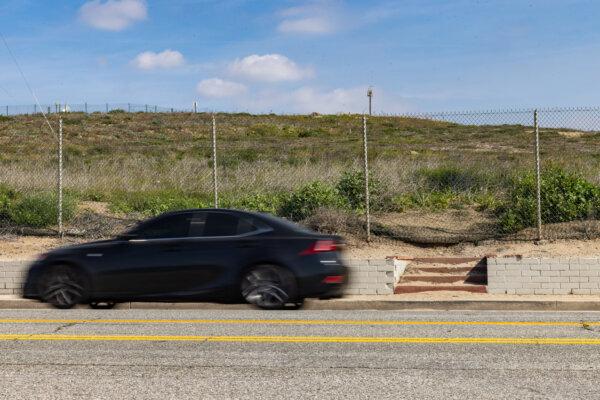
A car drives past a set of stairs that once led to a home in the abandoned Surfridge neighborhood in Playa Del Rey on Feb. 14, 2024. (John Fredricks/The Epoch Times)
“We used to have big parties and open gatherings on the Surfridge streets since it mostly sat empty during my time there,” Mr. Lind said. “But far as airplane noise in Playa del Rey, it’s always going to be there. Surfridge was used to it, and it was just a part of life.”
By 1975, all of Surfridge’s residents were fully relocated from the area, and the site was marked as condemned by Los Angeles officials. The neighborhood’s 54-year lifespan had come to an end.
Original ‘Residents’ Return
Aside from the telephone poles and pavement that mark the former location of the Surfridge neighborhood, many residents of Playa del Rey and visitors remain curious about the short gap of land connecting LAX with the Pacific Ocean.
“I’ve just always wondered why this area is empty and can imagine that it would be prime land since you can see both the ocean and the airport from it,” Playa Del Rey resident Esteban Copado told The Epoch Times. “The street names are even still listed on online maps.”
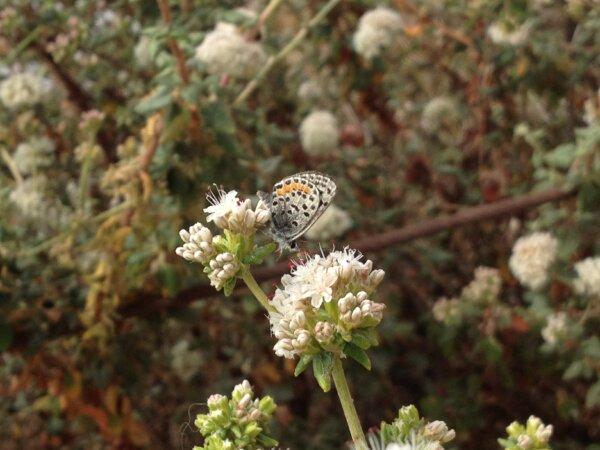
A federally endangered species, the El Segundo blue butterfly. (Eric Porter/USFWS/Public Domain)
But long before construction began at Surfridge in the 1920s, the sand dunes that once held the foundation of the town had formed thousands of years prior and were home to the El Segundo blue butterfly, which was close to going extinct, according to local conservationists.
Just one year after Surfridge’s final residents were relocated, the butterfly species native to the area was discovered to be one of the last populations remaining in the world and was listed as endangered by U.S. Fish and Wildlife Service in 1976.
“The LAX dunes are the largest historical contiguous habitat of the El Segundo blue butterfly throughout its range,” Neysa Frechette, manager of scientific programs for conversation group Friends of Ballona Wetlands, told The Epoch Times. “Any relatively undisturbed habitat in the southern portion of the dunes that existed before the airport was rebuilt and now continues to support the butterflies.”
The area is now known as the El Segundo Blue Butterfly Preserve.
Since preservation efforts began, the blue butterfly population went from an estimated 500 to an estimated 17,000, according to LAX officials.
“[Both] LAWA and The Bay Foundation are working to fully restore this habitat,” Ms. Frechette said.
As the native butterflies repopulate the area, those who obtain a window seat on an airplane departing LAX can still see the grid of streets that sit just past the runways of the busiest airport on the U.S. West Coast.
And for those out for an evening walk, streetlights placed along Vista Del Mar on the boundary of the former development still illuminate the way for a neighborhood that no longer exists.
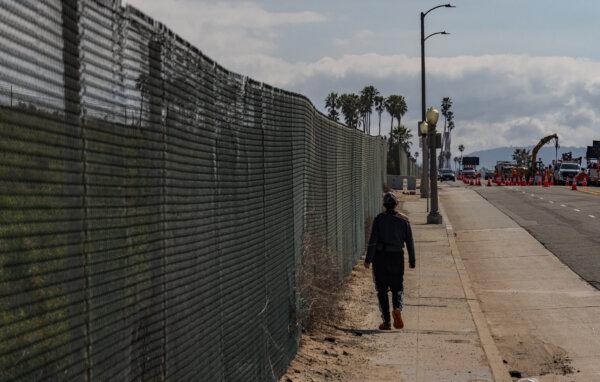
A woman walks along the edge of the former Surfridge neighborhood in Playa Del Rey on Feb. 14, 2024. (John Fredricks/The Epoch Times)


